Input interpretation

SMILES: PCl
Basic properties
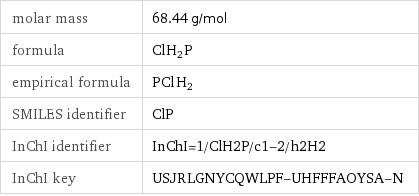
molar mass | 68.44 g/mol formula | ClH_2P empirical formula | P_Cl_H_2 SMILES identifier | ClP InChI identifier | InChI=1/ClH2P/c1-2/h2H2 InChI key | USJRLGNYCQWLPF-UHFFFAOYSA-N
Lewis structure
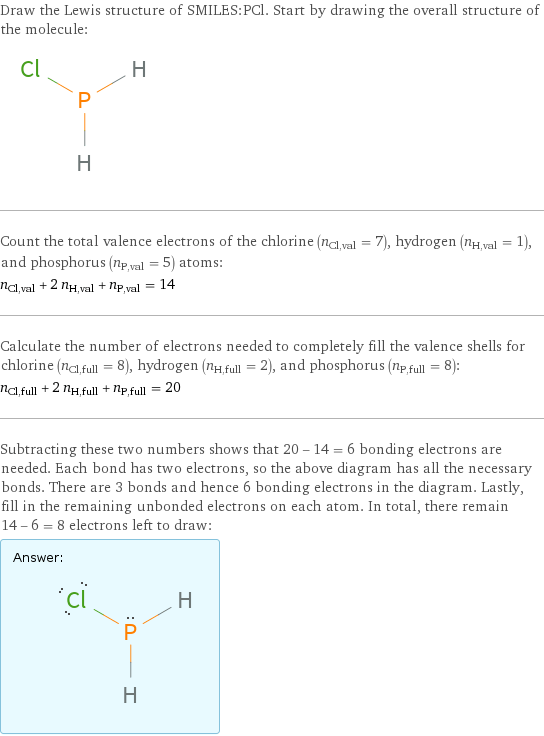
Draw the Lewis structure of SMILES:PCl. Start by drawing the overall structure of the molecule: Count the total valence electrons of the chlorine (n_Cl, val = 7), hydrogen (n_H, val = 1), and phosphorus (n_P, val = 5) atoms: n_Cl, val + 2 n_H, val + n_P, val = 14 Calculate the number of electrons needed to completely fill the valence shells for chlorine (n_Cl, full = 8), hydrogen (n_H, full = 2), and phosphorus (n_P, full = 8): n_Cl, full + 2 n_H, full + n_P, full = 20 Subtracting these two numbers shows that 20 - 14 = 6 bonding electrons are needed. Each bond has two electrons, so the above diagram has all the necessary bonds. There are 3 bonds and hence 6 bonding electrons in the diagram. Lastly, fill in the remaining unbonded electrons on each atom. In total, there remain 14 - 6 = 8 electrons left to draw: Answer: | |
Quantitative molecular descriptors
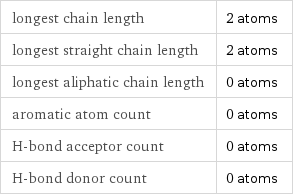
longest chain length | 2 atoms longest straight chain length | 2 atoms longest aliphatic chain length | 0 atoms aromatic atom count | 0 atoms H-bond acceptor count | 0 atoms H-bond donor count | 0 atoms
Elemental composition

Find the elemental composition for SMILES:PCl in terms of the atom and mass percents: atom percent = N_i/N_total × 100% mass percent = (N_im_i)/m × 100% Plan: • Write the chemical formula and gather atomic masses from the periodic table. • Determine values for N_i, m_i, N_total and m using these items. • Finally, compute the percents and check the results. Write the chemical formula: ClH_2P Use the chemical formula to count the number of atoms, N_i, for each element and find the total number of atoms, N_total: | number of atoms P (phosphorus) | 1 Cl (chlorine) | 1 H (hydrogen) | 2 N_total = 1 + 1 + 2 = 4 Divide each N_i by N_total to calculate atom fractions. Then use the property that atom fractions must sum to one to check the work: | number of atoms | atom fraction P (phosphorus) | 1 | 1/4 Cl (chlorine) | 1 | 1/4 H (hydrogen) | 2 | 2/4 Check: 1/4 + 1/4 + 2/4 = 1 Compute atom percents using the atom fractions: | number of atoms | atom percent P (phosphorus) | 1 | 1/4 × 100% = 25.0% Cl (chlorine) | 1 | 1/4 × 100% = 25.0% H (hydrogen) | 2 | 2/4 × 100% = 50.0% Look up the atomic mass, m_i, in unified atomic mass units, u, for each element in the periodic table: | number of atoms | atom percent | atomic mass/u P (phosphorus) | 1 | 25.0% | 30.973761998 Cl (chlorine) | 1 | 25.0% | 35.45 H (hydrogen) | 2 | 50.0% | 1.008 Multiply N_i by m_i to compute the mass for each element. Then sum those values to compute the molecular mass, m: | number of atoms | atom percent | atomic mass/u | mass/u P (phosphorus) | 1 | 25.0% | 30.973761998 | 1 × 30.973761998 = 30.973761998 Cl (chlorine) | 1 | 25.0% | 35.45 | 1 × 35.45 = 35.45 H (hydrogen) | 2 | 50.0% | 1.008 | 2 × 1.008 = 2.016 m = 30.973761998 u + 35.45 u + 2.016 u = 68.439761998 u Divide the mass for each element by m to calculate mass fractions. Then use the property that mass fractions must sum to one to check the work: | number of atoms | atom percent | mass fraction P (phosphorus) | 1 | 25.0% | 30.973761998/68.439761998 Cl (chlorine) | 1 | 25.0% | 35.45/68.439761998 H (hydrogen) | 2 | 50.0% | 2.016/68.439761998 Check: 30.973761998/68.439761998 + 35.45/68.439761998 + 2.016/68.439761998 = 1 Compute mass percents using the mass fractions: Answer: | | | number of atoms | atom percent | mass percent P (phosphorus) | 1 | 25.0% | 30.973761998/68.439761998 × 100% = 45.26% Cl (chlorine) | 1 | 25.0% | 35.45/68.439761998 × 100% = 51.80% H (hydrogen) | 2 | 50.0% | 2.016/68.439761998 × 100% = 2.946%
Elemental oxidation states

The first step in finding the oxidation states (or oxidation numbers) in SMILES: PCl is to draw the structure diagram. Next set every oxidation number equal to the atom's formal charge: There are 1 chlorine-phosphorus bond, and 2 phosphorus-hydrogen bonds in SMILES: PCl. For each of these bonds, assign the bonding electrons to the most electronegative element. First examine the chlorine-phosphorus bond: element | electronegativity (Pauling scale) | Cl | 3.16 | P | 2.19 | | | Since chlorine is more electronegative than phosphorus, the electrons in this bond will go to chlorine. Decrease the oxidation number for chlorine (by 1 for single bonds, 2 for double bonds, and 3 for triple bonds), and increase the oxidation number for phosphorus accordingly: Next look at the phosphorus-hydrogen bonds: element | electronegativity (Pauling scale) | P | 2.19 | H | 2.20 | | | Since hydrogen is more electronegative than phosphorus, the electrons in these bonds will go to hydrogen: Now summarize the results: Answer: | | oxidation state | element | count -1 | Cl (chlorine) | 1 | H (hydrogen) | 2 +3 | P (phosphorus) | 1
Orbital hybridization
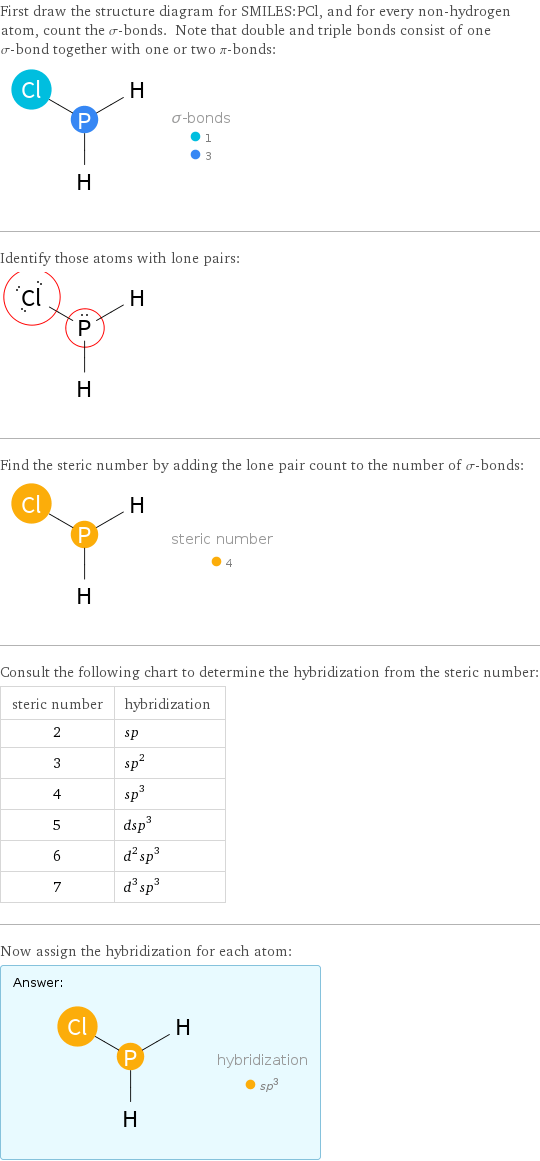
First draw the structure diagram for SMILES:PCl, and for every non-hydrogen atom, count the σ-bonds. Note that double and triple bonds consist of one σ-bond together with one or two π-bonds: Identify those atoms with lone pairs: Find the steric number by adding the lone pair count to the number of σ-bonds: Consult the following chart to determine the hybridization from the steric number: steric number | hybridization 2 | sp 3 | sp^2 4 | sp^3 5 | dsp^3 6 | d^2sp^3 7 | d^3sp^3 Now assign the hybridization for each atom: Answer: | |
Topological indices
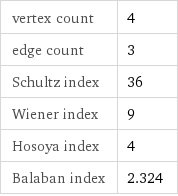
vertex count | 4 edge count | 3 Schultz index | 36 Wiener index | 9 Hosoya index | 4 Balaban index | 2.324